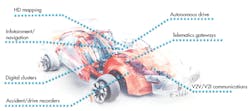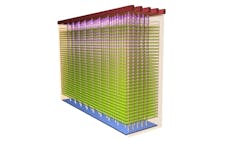NAND Flashes Its Storage Superiority in Automotive Designs
Download this article in PDF format.
Rapid-fire advances in high-reliability infotainment systems, advanced driver-assistance systems (ADAS), and autonomous cars are drastically altering the requirements of on-board storage. Many of these applications generate a high volume of data, which has engineers focusing more intently on coming up with efficient storage strategies.
A reliable, high-quality, and removable non-volatile memory enables more richness of content with these systems, and increases configuration options in the vehicle. The solution? The consensus appears to be NAND flash, which many designers see as being a catalyst in bringing about dramatic innovation and turning a car into one of the most connected devices available.
The development of car infotainment with ADAS and autonomous driving systems has increased the demand for NAND flash memory. With improved performance from 3D NAND, flash technology will be able to meet most of the stringent requirements for the next-generation automotive market.
All storage solutions have been designed and tested electrically to adhere to the AEC-Q100 standard. This guarantees the reliability and durability of electronic components after testing for temperature, electrostatic discharge (ESD), etc.
Secure Digital (SD) memory cards can satisfy automotive storage needs while meeting reliability and temperature-range requirements. Cards include advanced memory-management firmware such as electrical immunity, error-correction-code (ECC) systems for error diagnostics, wear-leveling algorithms, and "smart" functionality such as memory status monitoring and so on. Memory cards are also optimized according to typical automotive requirements, where the number of accesses (especially in reading) and component lifetime are more important than in, say, consumer applications.
Storage Solutions
Over the past 20 years, we have witnessed serious transitions in the automotive industry, from cars with minimal electronic content to electric and hybrid motor vehicles that contain several electronic control units (ECUs) for engine control, as well as electronic suspensions to ensure the appropriate standards of safety and reliability.
Currently, navigation and infotainment systems require the greatest amount of computing power and storage space. Collecting and storing reliable data is the basis for real-world visual processing, systems mapping, and analytical operations that involve markets beyond automotive, such as the industrial arena.
To handle the mountains of data, engineers are looking to develop the best storage strategy for their designs.
Storage solutions don’t rely on a single technology, but rather represent a synthesis of hardware, software, and design know-how.
In a self-driving car, a four-hour trip could generate more than 14 terabytes of data. But where does all of this data reside? Not all of it will be preserved, and what needs to be stored long-term will eventually be uploaded to cloud storage. Nonetheless, data will have to reside in a local memory.
Taking into account these considerations and overall automotive operating environments and production processes, NAND flash becomes the obvious choice for storage needs. Data is the essential element that connects system sensors to the car’s core. The ability to analyze and manage data in real time enhances the stability and security of any trip.
Automotive technology, coupled with vehicle-to-vehicle connectivity, requires a complex integration of sophisticated algorithms that are performed on powerful processors. It thus become even more crucial to have reliable, high-performance, and qualified storage solutions for working in tough environments characterized by extensive temperature, humidity and high vibration, such as automotive industry (Fig. 1).
NAND Flash
NAND flash memory is a non-volatile storage technology designed to reduce cost per bit and increase maximum chip capacity. It’s used in a vast array of devices that often load and replace large files such as MP3 players, digital cameras, and USB. NAND memory has a finite number of writing and erasing cycles, so any failure of operation is usually gradual as individual cells collapse and overall performance degrades.
New developments in NAND flash-memory technology include smaller chips, and increased reading and writing cycles. Backed by SD standards, NAND has also seen an exponential increase in memory capacity.
Faster interface speeds are needed, though, to reduce the access time for reading and writing. UHS-II and UHS-III (Ultra-High-Speed Class 2 and 3) can provide much higher bus speeds than UHS-I using low-voltage differential signals (LVDS).
A NAND flash cell’s internal structure typically leverages multi-level cell (MLC) technology to store bits of information across layers within a cell. MLC drives have a higher memory density and the cost per bit output is smaller than other topologies. When digital data is stored in a non-volatile memory, it must have a mechanism that can detect and correct a number of errors. ECC encodes the data so that a decoder can identify and correct errors in the data flow. Typically, data strings are encoded by adding a number of redundant bits. When the original data is reconstructed, a decoder examines the encoded message to check for any errors (Fig. 2).
3D NAND
Another flash data-storage technology known as 3D NAND involves multi-layer silicon cutting, stacking memory cells to increase density, and allowing cells to span on each layer by reducing interference from adjacent cells. 3D NAND for SD cards uses a series of floating-gate transistors, assigned to an "on" and "off" charge value (1 and 0 bit). These memory blocks are arranged side by side in a two-dimensional layout.
The production process of 3D NAND is less complicated than other alternative technologies—it uses the same material, but with small modifications to produce simple NANDs (Fig. 3). It’s expected that mass production of 3D NAND flash memory will lead to less expensive and more reliable storage solutions.
Conclusion
Of all automotive applications, ADAS is the fastest growing area. The data logging and the processing analytics need both DRAM and flash memories. The latter’s robust structure makes it a good fit in automotive applications, with the ability to withstand rugged conditions. Specifically, they offer an industry-grade temperature range with advanced control techniques.
Due to NAND flash’s complexity, any reduction in its geometry would further elevate its stature as a storage solution. However, intrinsic challenges still must be worked out, and they require sophisticated memory-management techniques.
About the Author
Maurizio Di Paolo Emilio
Maurizio Di Paolo is the author of Microelectronic Circuit Design for Energy Harvesting Systems, a book covering the design of microelectronic circuits for energy harvesting, broadband energy conversion, and new methods and technologies for energy conversion.




